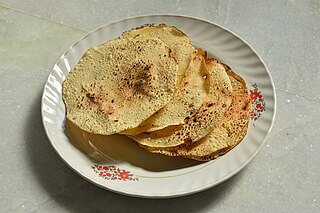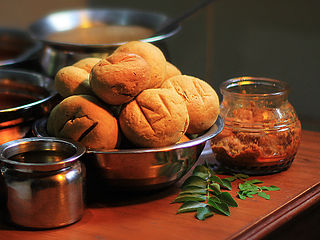Related Research Articles

A dosa is a thin, savoury crepe in South Indian cuisine made from a fermented batter of ground white gram and rice. Dosas are served hot, often with chutney and sambar. Dosas are popular in South Asia as well as around the world.

Vigna mungo, also known as black gram, urad bean, urid bean, matimah, matikolai, mash kalai, maas/kalo daal, uzhunnu parippu, ulundu parippu, minapa pappu, uddu, or black matpe, is a bean grown in South Asia. Like its relative, the mung bean, it has been reclassified from the Phaseolus to the Vigna genus. The product sold as black lentil is usually the whole urad bean, whereas the split bean is called white lentil. It should not be confused with the much smaller true black lentil.

Punjabi cuisine is a culinary style originating in the Punjab, a region in the northern part of South Asia, which is now divided in an Indian part to the east and a Pakistani part to the west. This cuisine has a rich tradition of many distinct and local ways of cooking.

Pakora is a fritter originating from the Indian subcontinent. They are sold by street vendors and served in restaurants in South Asia. It consists of items, often vegetables such as potatoes and onions, coated in seasoned gram flour batter and deep fried.

Gulab jamun is a sweet confectionary or dessert, originating in the Indian subcontinent and a type of mithai popular in India, Pakistan, Nepal, the Maldives, and Bangladesh, as well as Myanmar. It is also common in nations with substantial populations of people with South Asian heritage, such as Mauritius, Fiji, Gulf states, the Malay Peninsula, Great Britain, South Africa, and the Caribbean countries of Jamaica, Trinidad and Tobago, Guyana, and Suriname.

A papadam, also known as papad, is a snack that originated in the Indian subcontinent. Dough of black gram bean flour is either deep fried or cooked with dry heat until crunchy. Other flours made from lentils, chickpeas, rice, tapioca, millet or potato are also used. Papadam is typically served as an accompaniment to a meal in India, Pakistan, Bangladesh, Nepal, Sri Lanka and the Caribbean or as an appetizer, often with a dip such as chutneys, or toppings such as chopped onions and chili peppers, or it may be used as an ingredient in curries.

Rajasthani cuisine is the cuisine of the Rajasthan state in North West India. It was influenced by various factors like the warlike lifestyles of its inhabitants, the availability of ingredients in an arid region and by Hindu temple traditions of sampradayas like Pushtimarg and Ramanandi. Food that could last for several days and could be eaten without heating was preferred. Scarcity of water and fresh green vegetables have all had their effect on the cooking. Signature Rajasthani dishes include Dal Baati Churma, Panchratna Dal, Papad ro Saag, Ker Sangri, Gatte ro Saag. It is also known for its snacks like Bikaneri bhujia, Mirchi bada and Kanda kachauri. Other famous dishes include Dal Baati, malaidar special lassi (lassi) and Lashun ki chutney, Mawa lassi from Jodhpur, Alwar ka mawa, Malpauas from Pushkar and rasgulla from Bikaner, "paniya"and "gheriya" from Mewar. Originating for the Marwar region of the state is the concept Marwari Bhojnalaya, or vegetarian restaurants, today found in many parts of India, which offer vegetarian food of the Marwari people. The history also has its effect on the diet as the Rajputs preferred majorly a non-vegetarian diet while the Brahmins, Jains, Bishnois and others preferred a vegetarian diet. So, the state has a myriad of both types of delicacies.

Barfi or burfi is a milk-based sweet from the Indian subcontinent with a fudge-like consistency. Its name comes from the Persian and Urdu word (barf) for snow. Barfi is consumed throughout India and Pakistan and is especially popular in North India. It is often served at celebrations and religious festivals such as Diwali and Holi.

Sindhi cuisine refers to the distinct native cuisine of the Sindhi people from Sindh, Pakistan. Sindhi cuisine has been influenced by Central Asian, Iranian, Mughal food traditions. It is mostly a non-vegetarian cuisine, with even Sindhi Hindus widely accepting of meat consumption. The daily food in most Sindhi households consists of wheat-based flat-bread (Mani) or rice accompanied by two dishes, one gravy and one dry with curd, papad or pickle. Freshwater fish and a wide variety of vegetables are usually used in Sindhi cuisine. Restaurants specializing in Sindhi cuisine are rare, although it is found at truck stops in rural areas of Sindh province, and in a few restaurants in urban Sindh.

Khichdi or khichri is a dish in South Asian cuisine made of rice and lentils (dal) with numerous variations. Variations include bajra and mung dalkhichri. In Indian culture, in several regions, especially in the northern areas, it is considered one of the first solid foods that babies eat.
Bhojpuri cuisine is a style of food preparation common among the Bhojpuri people of Bihar and eastern Uttar Pradesh in India, and also the Terai region of Nepal. Bhojpuri foods are mostly mild and tend to be less hot in terms of spices used. The cuisine consists of both vegetable and meat dishes.

Besan Chakki or Besan Katli or Besan Khandli is a common chakki sweet from the Indian subcontinent. It is made with besan, condensed milk, and sugar.

Panjiri is a Ayurvedic sweet dish from the Indian subcontinent which is specially prepared for Krishna Janmashtami festival. The sweet panjiri evolved from an Ayurvedic preparation called Panchajīraka.
Awadhi cuisine is a cuisine native to the Awadh region in Northern India and Southern Nepal. The cooking patterns of Lucknow are similar to those of Central Asia, the Middle East, and Northern India and western India with the cuisine comprising both vegetarian and non-vegetarian dishes. The Awadh region has been influenced by Mughal cooking techniques, and the cuisine of Lucknow bears similarities to those of Central Asia, Kashmir, Punjab and Hyderabad. The city is also known for its Nawabi foods.

Laapsi or lapsi is an Indian sweet dish made using grain flour or broken wheat and ghee, along with milk, nuts, raisins and other dried fruits. Lapsi is commonly prepared during Hindu ceremonies and is served as a religious offering to Devtas. Lapsi forms an integral part of North Indian cuisine and has many variants.

Malaysian Indian cuisine, or the cooking of the ethnic Indian communities in Malaysia, consists of adaptations of authentic dishes from India, as well as original creations inspired by the diverse food culture of Malaysia. Because the vast majority of Malaysia's Indian community are of South Indian descent, and are mostly ethnic Tamils who are descendants of immigrants from a historical region which consists of the modern Indian state of Tamil Nadu and Sri Lanka's Northern Province, much of Malaysian Indian cuisine is predominantly South Indian inspired in character and taste. A typical Malaysian Indian dish is likely to be redolent with curry leaves, whole and powdered spice, and contains fresh coconut in various forms. Ghee is still widely used for cooking, although vegetable oils and refined palm oils are now commonplace in home kitchens. Before a meal it is customary to wash hands as cutlery is often not used while eating, with the exception of a serving spoon for each respective dish.

Tehri or tahri is a yellow rice dish in North Indian cuisine. Spices are added to plain cooked rice for flavor and colour. In one version of tehri, potatoes are added to the rice.
Panchratna dal is a popular dal in the Indian subcontinent and Indian-origin communities in Guyana, Suriname, and Trinidad and Tobago. Lentils are an integral part of Indian cuisine. This is a dish customarily served on special occasions. It is usually accompanied by an Indian flatbread or roti.

In Indian cuisine, dal, paruppu, or pappu are dried, split pulses that do not require soaking before cooking. India is the largest producer of pulses in the world. The term is also used for various soups prepared from these pulses. These pulses are among the most important staple foods in South Asian countries, and form an important part of the cuisines of the Indian subcontinent.

Daal Baati is an Indian dish of daal (lentils) and baati. It is popular in Rajasthan, Madhya Pradesh, Maharashtra's Khandesh and Vidarbha region, Gujarat, and Uttar Pradesh.
References
- ↑ Brien, Charmaine O' (15 December 2013). The Penguin Food Guide to India. Penguin UK. ISBN 978-93-5118-575-8.
- ↑ Prabhat Brihat Hindi Shabdakosh (vol-1) (in Hindi). Prabhat Prakashan. 1 January 2010. ISBN 978-81-7315-769-1.
- ↑ Saranāmasiṃha; Śarmā, Saranāmasiṃha (1968). Hind ̄kī tadbhava śabdāvalī (in Hindi). Kāleja Buka Ḍipo.